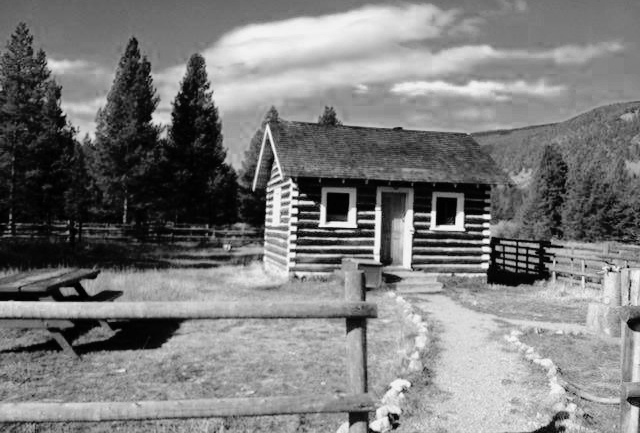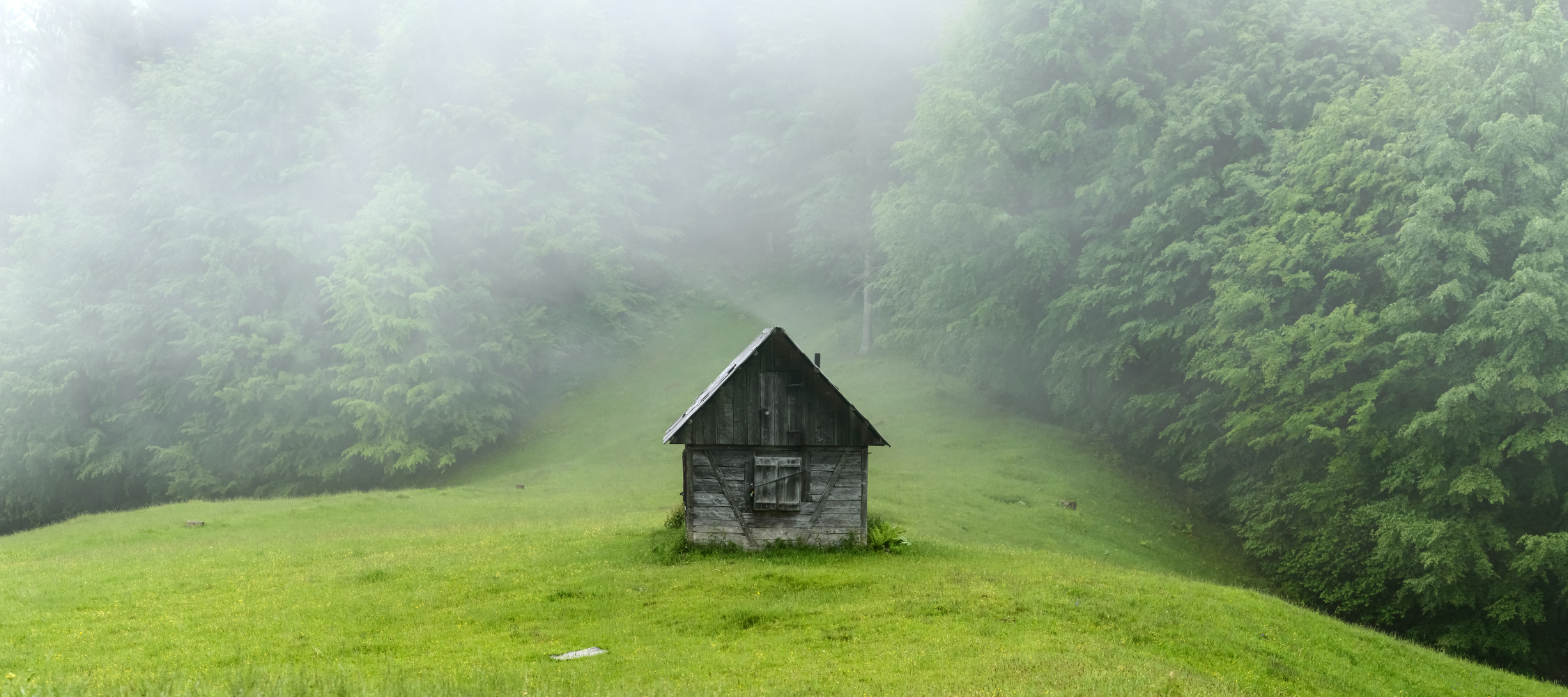Hogback Homestead
Located just outside of Missoula, Rock Creek is a fisherman’s and adventurer’s paradise. It is also home to two mysterious United States Forest Service cabins.
The first is Hogback Homestead. This is a personal favorite of mine only because I had a bit of a — shall we say — spooky experience while staying there. My sister, mother, and respective children stayed at Hogback for a weekend. The cabin is quite lovely and is more of a quaint and welcoming cottage than a log cabin in the woods. With a beautiful front porch, perched on the banks of Hogback Creek, and appointed with period-correct furniture, it feels like you’ve stepped back into an idyllic time.
The weekend we visited Hogback Homestead was perfect – there was a chill in the air, and you could smell the earth — a spicy medley of pine needles and aspens mixed with the occasional waft of willow trees and water bushes.
As we explored the immediate surroundings and the inside of Hogback Homestead, we found that the house was equipped with an electrically wired doorbell (the only electricity in the house), which was quite a technical achievement for its time. We all raised an eyebrow as we thought, “A doorbell for whom?” This place was MILES from anywhere and positioned so you could see a visitor coming for an eternity. It also had a strange, small, locked room upstairs and nobody could quite figure out how that space might have been used.

An Evening at Hogback Homestead
As dusk fell upon us, we laid a fire in the wood stove, played games, told stories, and speculated about the history of the cabin. As smoke curled from the chimney and the old-fashioned propane lights glowed in the dark night, Hogback Homestead weaved its magic. As the night wore on, and much merry-making drew to a well-fed, relaxed, and sleepy close, we all decided to retire for the evening. The home has two bedrooms upstairs and a bedroom downstairs. It’s not plumbed, but there is a luxurious outhouse about 50 yards from the front door. For the younger children and scaredy cats, we devised a buddy system should anyone need to use the restroom in the middle of the night. Without light pollution, the night was pitch black and cold, so nobody relished the idea of an icy visit to the outdoor water closest.
We all retired to our beds for what I thought would be a long, peaceful night’s sleep. My seven-year-old daughter, who was slightly scared to be in a cabin in the middle of nowhere after dark, snuggled in next to me and we drifted off to sleep. The bed offered a comfort level befitting a Forest Service cabin, so my dozing was easily interrupted by the sound of my niece and nephew trampling down the stairs with the grace of an elephant. Assuming that they were headed outside to use the facilities, I didn’t pay any attention. After the fourth clattering trip down the stairs, and out the door that they continued to let slam shut upon each exit, I figured that perhaps they had eaten something that didn’t agree with them. I got up to see if they were okay.
Everyone in the house was sleeping soundly.
The heavy knowledge that someone — or something — other than my family had been clumsily running a 5K up and down the stairs for the better part of the night was unsettling, to say the least. I took a few deep breaths, calmed my nerves, and listened – nothing. Not a peep. Just the soft snores of various family members throughout the house. I settled back in bed, chiding myself for letting my imagination get the better of me. This wasn’t like me. My mom and dad had raised us in a cabin that was miles from civilization in the Bitterroot Mountains. The only difference between the house we grew up in and the Hogback was our house was slightly larger, with electricity, and had running water…sometimes. “Just my imagination,” I told myself, as I tried to drift off to sleep. Sleep was elusive, and I looked forward to the first tendrils of dawn and a good, strong cup of coffee to help clear the cobwebs from my head.
5 Spooky Secrets About Garnet Ghost Town >>>
The next morning, as is my tradition whenever our family goes camping or spends a weekend together, I got ready to cook a big breakfast for everyone. With the unsettling night behind me and a day of family bonding and fun ahead of me, I stoked up the wood stove and got to work on the old, propane cook stove. Because the cabin was sans running water, I introduced myself to the outdoor hand pump. Gourmet breakfast preparation under semi-adverse conditions? I was up for the challenge.
As the warmth of the fire and the mingling smells of breakfast began filling the house, family members began to stir. One by one, we all settled around the breakfast table chortling and planning our day, when my mother asked how everyone had slept. Her question was met with deafening silence, as if everyone had something they wanted to say, but dared not. I broke the silence and said that I hadn’t slept all that well and asked who had made so many trips outside during the night. The answer?
No one.
My mother looked confused and said, “No one? I heard one of you go up and down those stairs at least four times.” It turns out that in addition to the stairs, the sound of shoveling was heard, as were the sounds of a muted conversation in the living room, and the sound of someone tending the fire. It seemed that each one of us had heard something go bump in the night. If my imagination was overactive, at least I was in good company. We all silently reflected on the information, and since we’re never short on humor, someone cracked a joke and we continued with our meal and day.
10 Fall Recipes That Will Make Your Sweaters and Pumpkin Latte Weep >>>
After breakfast, we decided to take a walk through the fields and woods out behind the homestead. We found two, old broken-down log cabins, and an intricate flume, made of wood that was dug into the ground and spanned beyond the length of our walk. We found several rock formations and rock ‘walls,’ which were really fences constructed from clearing the surrounding fields of rock. The brook babbled steadily in the distance.
We had rented the homestead for a second evening, but that afternoon, the adult children headed back to Missoula. It was just going to be me, my daughter, my sister, and our mom. I didn’t want to go, but my sister and mother both said something like, “Expletive, no, we don’t want to stay out here for another night.” So off we rode.
Unraveling Hogback Homestead’s Mysteries
I watched Hogback Homestead disappear in my rearview mirror, but I was so struck by the bewitching energy that surrounded us, an energy that I couldn’t quite put my finger on but was so palpable that even 10 years later, I haven’t been able to completely shake my obsession with the Hogback Homestead. My experience left me with several questions, and so the research began.
- What is a Hogback? A hogback is a long narrow expanse of land, formed by rock exposed by erosion that resembles its namesake, a hog’s back. Additionally, you can generally find several hogback formations in the same area. Hogback formations create long skinny valleys between the rocky ridges. Some say that energy becomes trapped in the long, narrow valleys between the hogbacks. Is this the palpable feeling that hangs over the Hogback? I had more questions.
- Who built such a technologically advanced home with an electric doorbell, and an engineered irrigation marvel in terms of the flume we had found on our walk? I’ll tell you who, a fella named Charles Gernard. Charles built the house in 1917 and was a farmer who spent countless years digging in his irrigation flume. The flume brought irrigation from the headwaters of Hogback Creek to the surrounding area. Charlie was quite ahead of his time in a number of ways as evidenced by his well-thought-out home, his farming and irrigation techniques, and his doorbell. Was the phantom shoveler Charlie? Eternally digging his irrigation flume?
- Philipsburg and surrounding areas were rich in gold, silver, copper, and other precious gems and mineral deposits. The area experienced a boom in the 1860s. Anyone from an area that has experienced a mining or logging boom knows that you may be standing in a remote, silent, inaccessible mountain meadow today, only to learn that there once may have been a mountain settlement of 3000+ people.
Mining communities were opportunistic and fleeting. Was that the case here? Was there actually a large settlement that surrounded the Hogback in 1917 that could explain the feeling that surrounded the area and that perplexing doorbell? When asking this question, I expected to learn that this area was a roaring mining encampment that saw a lot of use in the late 1800s and early 1900s. I didn’t discover that, but what I did discover is that the Hogback Homestead site was the site of more than one archeological dig with a supporting archeological report stating that the Forest Service had found several artifacts while renovating the home. Further investigation yielded evidence of historic and PRE-historic human encampments dating back thousands of years. From flint tools, tipi rings, and vision quest structures to farm implements and projectiles, the signs of human inhabitation date back at least 10,000 years.

Morgan Case Homestead
You can’t research Hogback Homestead without also being made aware of the Morgan Case Homestead, just two miles up Rock Creek Road past the Hogback house. The Morgan Case Homestead was homesteaded by a former slave, Agnes ‘Annie’ Morgan. It is said that Annie cooked for General George Armstrong Custer, and after his passing, she traveled to Fort Benton with a regiment of Buffalo Soldiers.
While in Fort Benton, she met a man from Philipsburg, whether this man was the County Attorney of Philipsburg, David Durfee, I am unsure, but at some point, Durfee hired Annie to care for his alcoholic uncle. Annie was charged with the task of helping Durfee’s uncle dry out at an abandoned farm 20 miles outside of Phillipsburg. Annie nursed the man back to health. When Durfee’s uncle left, Annie filed and received a homestead claim, which she held until her death in 1914.
Annie was completely self-sufficient on her homestead and known for her incredible Southern cooking. Being a woman ahead of her time, Annie offered a wilderness resort, of sorts, to hunters and fishermen, cooking for them and allowing them to camp and fish Rock Creek in front of her cabin.
Annie became known as a healer and would be called upon to help ill neighbors and ailing animals. When the Forest Service renovated Annie’s cabin, they found a bundle hidden above the front door that resembled bundles used and carried by African Root Doctors. Annie kept a black medical bag at the ready to help those in need.
One day, Annie came across a man who was severely ill with Typhoid fever, “Fisher” Jack Case. Typhoid fever was commonly fatal, but Annie was able to nurse Jack back to health. To repay Annie for saving his life, Jack fenced Annie’s homestead for her. Jack and Annie became an item and Jack stayed on at Annie’s homestead. Annie passed away in 1914, but her legend lives on. Her homestead is on the Historic Registry, and she was inducted into the Montana Cowboy Hall of Fame in 2013.

Moose Lake Forest Service Cabin
One last Forest Service Cabin in the area is Moose Lake Cabin. While not shrouded in mystery and folklore like the other cabins, it is still a fantastic place to go camping with the kids. Located 24 miles outside of Philipsburg, it is a charming one room cabin that sleeps four, has a wood stove, and rests on the bank of the middle fork of Rock Creek. It was built in 1917 for Forest Service workers, but the only eerie thing about it is how unnervingly quiet it is at night.
Neighboring Philipsburg
Philipsburg is the closest town to these Forest Service cabins, and is known for its historical architecture, local brewery, awe-inspiring candy store (closed on Saturdays!), great food, and boutiques. If you decide to explore this entertaining town, make sure to stop by 201 South Sansome Street, a commercial/residential listing that is begging to be an artist studio or a bakery. Run your business on the main level and live in the quaint apartment above. When leaving Philipsburg, take a quick side trip to Georgetown Lake, take in Skalkaho Falls, and visit Hamilton via the Skalkaho Pass.
If you decide you’d like to stay in one of these cabins, be warned — you must book these cabins far in advance – but they are totally worth the wait. Visit recreation.gov to see when your cabin of choice is available.
Montana is never short on good stories and rich history. If you decide to stay at the Hogback Homestead, the Morgan Case Homestead, or Moose Lake Cabin, be sure to take a moment to appreciate the stories and histories of those who have stayed there before. Enjoy your stay!
Images via Kat Hobza
 Jenny Cannon is the Agent Service Manager for Glacier Sotheby’s International Realty, where she has the distinct pleasure of working with the greatest team of Agent Services Experts, an incredible marketing team, and the best agents in Montana. The GSIR team is not only incredibly talented, but also some of the finest people you’d ever want to know. When Jenny isn’t at work, you probably won’t find her, because she will be doing her best to get lost in the gorgeous mountains of Western Montana.
Jenny Cannon is the Agent Service Manager for Glacier Sotheby’s International Realty, where she has the distinct pleasure of working with the greatest team of Agent Services Experts, an incredible marketing team, and the best agents in Montana. The GSIR team is not only incredibly talented, but also some of the finest people you’d ever want to know. When Jenny isn’t at work, you probably won’t find her, because she will be doing her best to get lost in the gorgeous mountains of Western Montana.
Pick up of LIVE Montana at any Glacier Sotheby’s International Realty
location or enjoy the digital version here:




